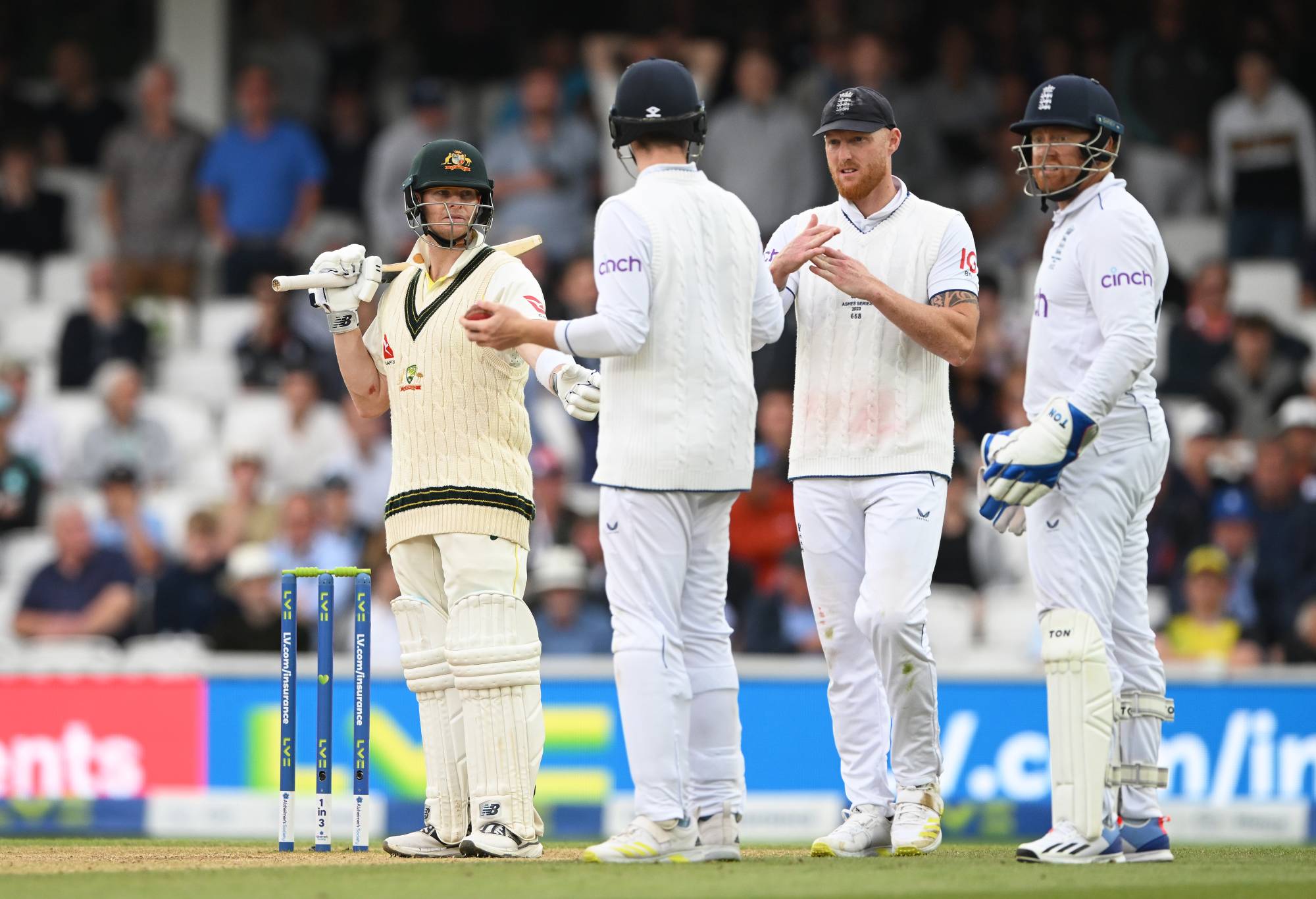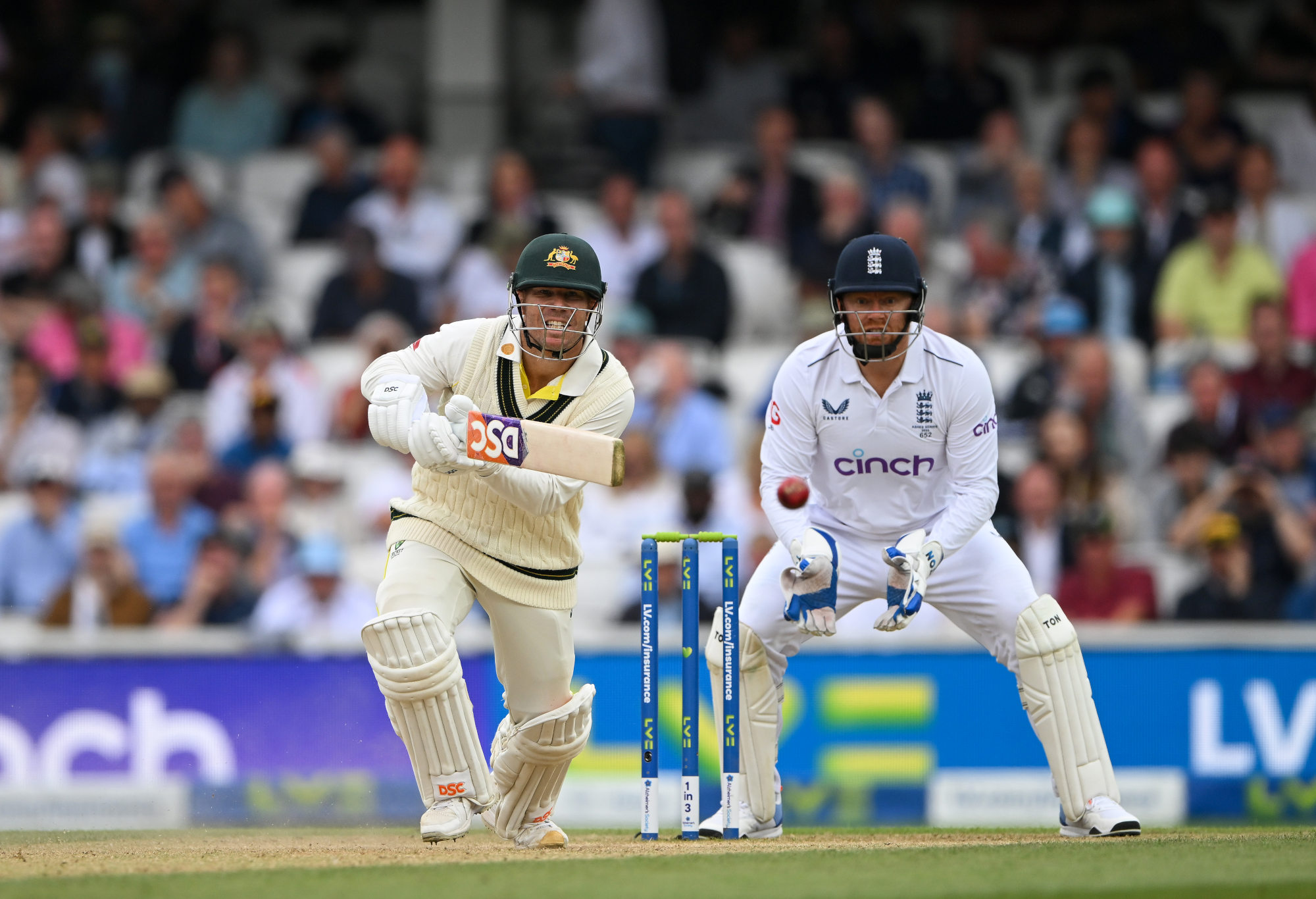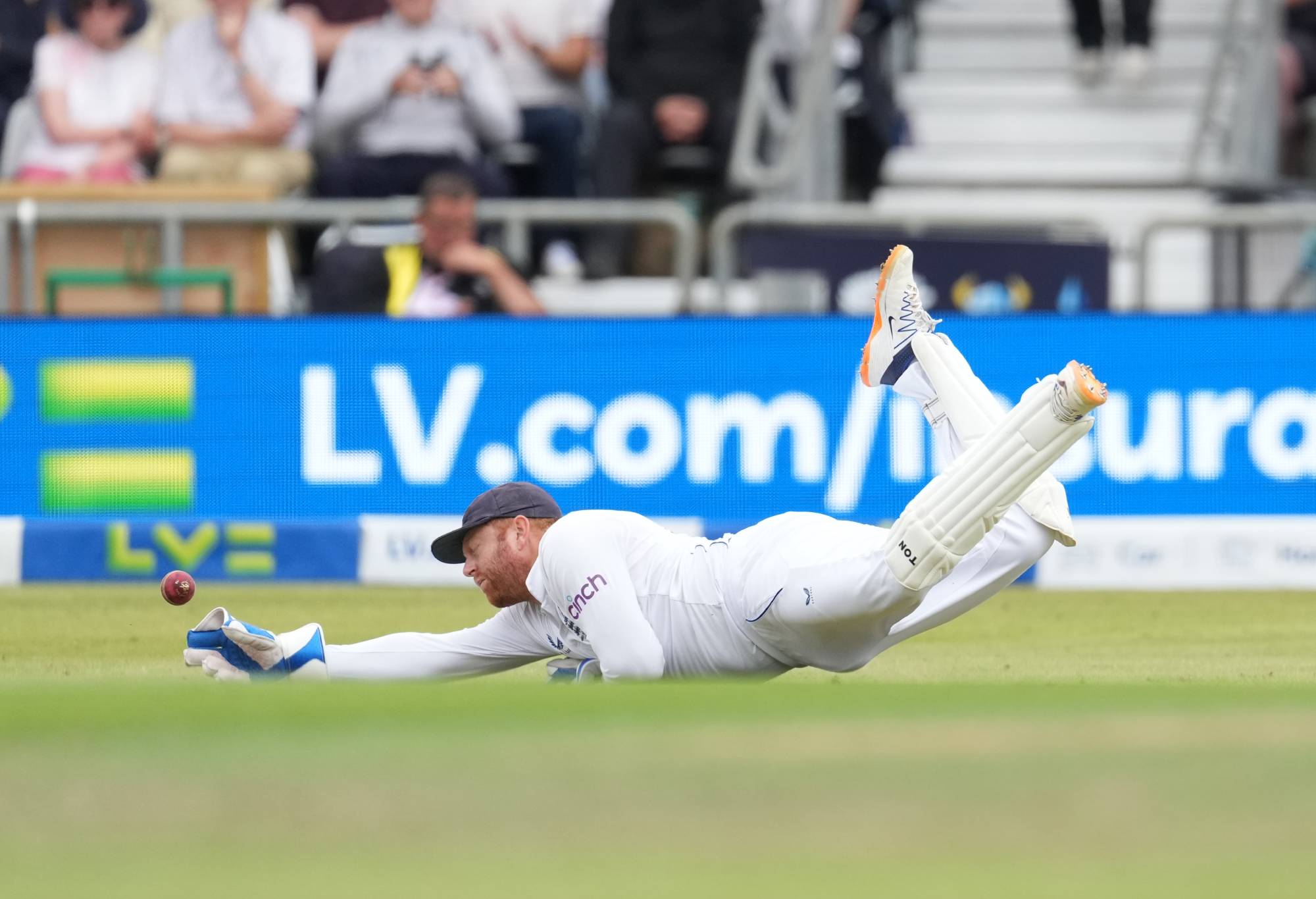In any sporting contest that finishes in a draw, one team is happier than the other.
England ended the 2023 Ashes on a high with smiles on their faces after farewelling retiring duo Stuart Broad and Moeen Ali at The Oval with a 49-run win to square the series 2-2.
And of course they have claimed yet another moral victory on the basis that they were on top in the fourth Test at Manchester when wet weather ruined any chance of a result on the final two days.
Same old England, always raining.
The Australians were decidedly more sombre after the final wicket fell at The Oval, forcing smiles for the cameras after Pat Cummins was presented with the urn they’ve regained with help from the weather gods.

Ben Stokes calls for a review after botching the Steve Smith catch. (Photo by Stu Forster/Getty Images)
But by the time they are jetting out of England after an arduous two-month mission, they will laugh last and laugh loudest.
Because all is fair in love and war, and cricket’s oldest rivalry falls into the latter category in the sporting sense.
They failed in their aim to be the first Australian team to win an Ashes series in England since 2001 but the next best thing is retaining the urn, particularly after officially sealing world Test champions status by beating India in the prelude.
Hindsight, like the shortest version of the game, is Twenty20 – here’s where each team needs to sharpen up their act.
Manage, strategise & dominate. Download Wicket Cricket Manager today!
Australia
Tactics too negative
Cummins sensibly adopted defensive field positions when faced with the Bazball onslaught to avoid England bashing too many boundaries.
But he overdid the spread field settings, often having a deep point or a sweeper on the leg side when batters were new to the crease or when more fielders in the infield or catchers in the cordon would have been a better option.
With their batting, the Aussies fell into the trap on a few occasions of occupying the crease without moving the game forward so when England’s bowlers did make breakthroughs, it put the tourists on the back foot and the process would repeat itself.
Marnus Labuschagne, Cameron Green when he played and even Steve Smith took it too slow at the start of their innings and when they didn’t convert those starts into substantial scores, the pressure piled up on the batters to follow.
Squad mentality just a catchphrase
Australia pushed the mantra of a squad mentality from the moment they touched down in England, particularly with their bowlers but it didn’t prove to be the case.
When push came to shove they persisted with Cummins, Mitchell Starc and Josh Hazlewood.
In most instances it’s hard to say no to that world-class trio but when you are playing six Tests in a little more than seven weeks, physical and mental fatigue sets in.
Cummins looked spent late in the Ashes and his bowling tailed off while Hazlewood was tradesmanlike without being overly threatening after his recent injury-enforced layoffs.
Scott Boland was correctly jettisoned after a couple of uncharacteristically unproductive forays against England while for the second straight Ashes tour, Michael Neser’s only contribution to the squad was as an occasional substitute fielder.
England brought in a very similar bowler in Chris Woakes midway through the series and it not only swung the momentum their way, he ended up winning the Compton-Miller Medal despite playing just three matches.

David Warner. (Photo by Stu Forster/Getty Images)
Warner gamble backfired
There’s officially nothing more to add on this topic. As was blatantly obvious prior to the start of the series, the selectors were not going to drop him and he delivered modest returns which ultimately proved costly when you compare the effectiveness of the two opening duos. He joked last week about playing on after his planned farewell at the SCG Test in January – you wouldn’t put it past these selectors to allow him to do so even if he continues to struggle in the three-match home series against Pakistan.
Injection of youth needed
The Australian team which went down in the fifth Test contained just one player under 29 – Todd Murphy and the 22-year-old spinner was only in the side because the 35-year-old first-choice option, Nathan Lyon, was injured.
Green will regain his place in the near future while the likes of Lance Morris, Jhye Richardson, Will Sutherland, Matt Renshaw, Will Pucovski, Aaron Hardie and further down the track, Teague Wyllie and Ashley Chandrasinghe, need to be given a decent chance to show they can cut it at Test level.
England
Bazball doesn’t work if it’s reckless
England are certainly on a winner with the theory of Bazball, however they ultimately paid the price of not regaining the urn not because of wet weather but because of reckless tactics in the first two Tests.
Attacking from the get-go spreads the field and then it should be a matter of maintaining the tempo, not wildly swinging at balls best left alone all in the name of entertainment value.
Former England captain Michael Vaughan said it best when he described the home team scaling back their tempo as “Bazball with brains”.
Harry Brook was the prime example – he threw his wicket away a couple of times when Australia were in vulnerable positions at Edgbaston and Lord’s but in the third Test at Headingley, he played sensibly while still ticking the scoreboard over in his match-winning 75 in the fourth-innings run-chase.
There is a confected nature to coach Brendon McCullum’s philosophy in that it relies on pitches made to measure so England should not expect too many batting friendly wickets when they travel, starting in January with India, a nation not known for preparing pitches that suit touring teams.

England’s Jonny Bairstow drops a catch from Australia’s Travis Head. (Photo by Danny Lawson/PA Images via Getty Images)
Bairstow is not a keeper
They rolled the dice by selecting Jonny Bairstow as their Test wicketkeeper after a few years as a specialist batter and due to the fact he had only recently returned from a devastating broken leg.
He showed he can be a game-changer as a middle-order strokemaker but although his efforts behind the stumps improved as the series wore on, some of his shoddy glovework in the first couple of matches was not up to Test standard and was decisive in those narrow losses.
Assuming Ben Stokes is able to return to bowling after knee surgery, the England team’s balance will enable them to shed a frontline bowler and that should open up a spot for Ben Foakes to return as wicketkeeper and allow Bairstow to concentrate on getting runs with the bat rather than worrying about conceding them with the gloves.
Time for younger bowlers
The English attack was the oldest since 1928 so that tells you all you need to know about how they need to start afresh.
Broad and Mooen have played their last Test and James Anderson wants to play on but if he struggles again in India after taking just five wickets in four matches at 85.4, he may need to be told his time is up if the record-breaker can’t see the writing on the wall.
Josh Tongue showed enough in the Ireland Test and his Ashes outing at Lord’s to suggest he is worth a shot at nailing down a long-term berth.
Woakes and Mark Wood are entering their mid 30s and need to be the new Broad and Anderson at least for the next couple of years while England’s greatest hope of becoming a world-class attack rests on the surgically repaired right elbow of Jofra Archer.
The 28-year-old speedster doesn’t look like he will ever be consistently available for Test duty due to his string of injuries and lucrative IPL deal but in an ideal world, England would be able to interchange Archer, Wood, Tongue and Olly Stone as their pace spearheads, complemented by toilers like Woakes, Matthew Potts and Jack Leach when his back is better.
Duckett-Crawley can be long-term combo
England have struggled for a reliable opening combination since the glory days of Andrew Strauss and Alastair Cook but they looked to have found a potential duo for the long haul.
Ben Duckett and Zak Crawley could look less alike but their left-hand/right-hand back-foot/front-foot dominant complementary nature has the potential to annoy new-ball bowlers for several years.
Duckett is a bit of a late bloomer at 28 while Crawley, 25, has been lucky to get an extended crack at the Test team despite middling returns prior to this series.
They averaged 39.89 per opening stand for the series with each opener striking above 75 as Crawley topped the Ashes averages at 53.33.
England’s only chance of being competitive in the next series in Australia is to have sturdy performers with the new ball and at the top of the order otherwise their winless streak which stretches back to the SCG Test of 2011 will continue.































































































